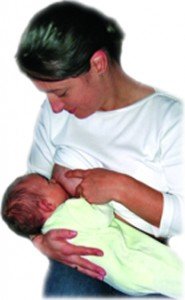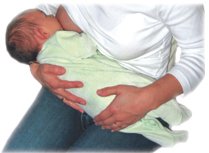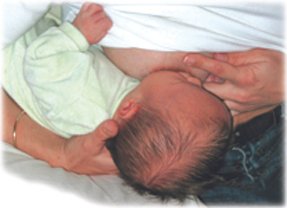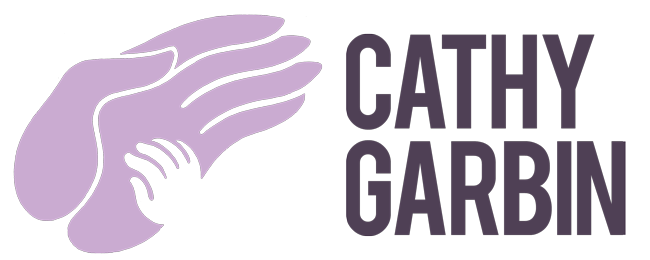Positioning and Attachment
The way a baby is held during breastfeeding can make a big difference to how she or he feeds. Babies who feel comfortable, relaxed and secure feed better.
…below you will find instructions and a small video for three good breastfeeding positions: ‘The Cradle Hold’, ‘The Football Hold’ and ‘The Lying Down Position’.
The Cradle Hold
- Generally the most comfortable and flexible position (no props needed).
- Holding baby in this position often stimulates the baby to instinctively open their mouth wide and search for the breast (the ‘rooting reflex’). This reflex is an instinctive, involuntary response to a stimulus. For babies this response, along with many others, is to aid them to attach and breastfeed. Therefore it is a good idea to work with this natural instinct.
Instructions:
In this position the baby’s body is in alignment and faces yours. Your hand is splayed across your baby’s back. This ensures your baby feels well supported and is as close to your body/breast as possible.
 The “rooting reflex” comes into play when you get the position right for your baby, often babies will attach themselves at this point. You will see your baby’s head slightly tilt back, the mouth open wide and the tongue flatten allowing lots of breast tissue to fill the mouth which then stimulates another feeding reflex, the sucking reflex. When this is comfortable and your baby is actively feeding it means your nipple is well placed near the junction of the baby’s hard and soft palate.
The “rooting reflex” comes into play when you get the position right for your baby, often babies will attach themselves at this point. You will see your baby’s head slightly tilt back, the mouth open wide and the tongue flatten allowing lots of breast tissue to fill the mouth which then stimulates another feeding reflex, the sucking reflex. When this is comfortable and your baby is actively feeding it means your nipple is well placed near the junction of the baby’s hard and soft palate.
Ensure your body is well aligned and comfortable. Once your baby is attached his/her weight is supported by resting on your body and being cradled in your arms.
 Your baby’s head will be higher than her/his body allowing gravity to help funnel the milk to the back of the throat, thereby stimulating the next feeding reflex, swallowing, depositing the milk into the stomach.
Your baby’s head will be higher than her/his body allowing gravity to help funnel the milk to the back of the throat, thereby stimulating the next feeding reflex, swallowing, depositing the milk into the stomach.
If you have pain in your breast/nipple when breastfeeding, it often means your baby is not attached well. Get help with attachment sooner rather than later.
The Football Hold (Rugby, not “Aussie Rules”)
- A good position for women with larger breasts.
- Useful for smaller babies.
Instructions:
 Place the palm of your hand firmly across your baby’s shoulders and make a cradle with your thumb and index finger for the base of baby’s head/upper-neck to rest in.
Place the palm of your hand firmly across your baby’s shoulders and make a cradle with your thumb and index finger for the base of baby’s head/upper-neck to rest in.
Your baby lies on her/his back. In this position you can look directly into each other’s eyes. Your baby’s body is “winged in” by keeping your elbow close to your body. Using the thumb of the other hand gently tilt your nipple upwards by pressing in and up.  Bring your baby to your breast as he/she opens their mouth, making the first point of contact on your baby’s bottom lip with the breast 3-4 cm below your nipple (pivot point). Then fold the rest of the breast and nipple into baby’s mouth.
Bring your baby to your breast as he/she opens their mouth, making the first point of contact on your baby’s bottom lip with the breast 3-4 cm below your nipple (pivot point). Then fold the rest of the breast and nipple into baby’s mouth.
The Lying Down Position
- A relaxing position. Lying down and resting helps if you are feeling tired and tense; helping your body to “let down” the milk. The “let down” reflex also known as the “milk ejection reflex” is responsible for releasing the hormone oxytocin so your milk will readily flow .
- This position is also great for babies who have a sore head/neck from experiencing a tough birth.
- It enables lots of skin to skin contact, which is known to increase milk supply by increase feeding hormones in both mother and baby, and give baby a strong sense of security.
Instructions:
 Lie on your back slightly tilting to the side (by putting a pillow just under your back to rest back on) you wish to feed from, with two pillows under your head. With your lower arm lying close to her body, position your baby to lie on her side.
Lie on your back slightly tilting to the side (by putting a pillow just under your back to rest back on) you wish to feed from, with two pillows under your head. With your lower arm lying close to her body, position your baby to lie on her side.
Your baby’s head should be placed so as to be slightly tilted back, in line with the breast. Your forearm will therefore be running right across your baby’s back.
 Tilt your nipple with the index finger of the upper hand, and at the same time swoop baby closer to you with the forearm on which your baby’s back is resting.
Tilt your nipple with the index finger of the upper hand, and at the same time swoop baby closer to you with the forearm on which your baby’s back is resting.
